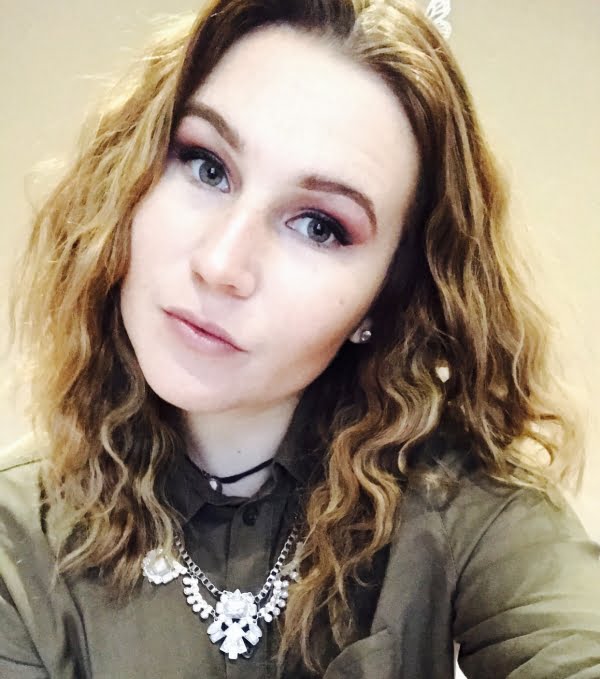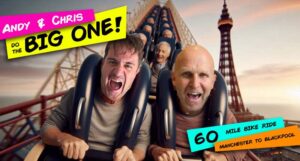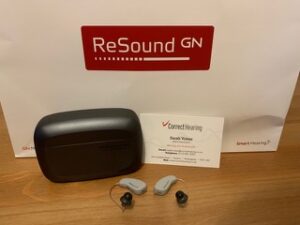I recently visited the ATOS London Offices, for an appointment set up by my Mum, Jane.
We were there to meet with Dr McKillop to discuss varying issues and negative experiences I and many others have endured at PIP assessments and as a result of inappropriate awards for many of us living with Usher Syndrome or Retinitis Pigmentosa (RP).
The meeting was set for 2:30pm purposely so I could travel to London outside of rush hour. Mobility for the deafblind/blind is stressful anytime of the day but particularly in busy periods.
I had been involved with with the original pilot assessment for PIP, as a result I was not overly concerned about my assessment, unlike many who not only find filling out the application form stressful and inappropriate for people with sensory impairment and need assistance completing it.
I am lucky my Mum has always taken care of forms for me and as capable as I am I dread the day I have to do form filling alone.
I shouldn’t feel that way, with real understanding, using the assistive technology available and good lines of communication there has to be a far more appropriate way of doing things that do not cause so much distress.
Finding a better way is something I would like to work on with whoever would like to work with me.
Planning the journey into London was much easier with my Mum as she was able to drive us both to a tube station. The tube is much easier to use than the mainline train, however, it isn’t easy.
On this occasion, Mum decided to drive and park at Hounslow West tube station, so we could take the Piccadilly line, followed by the Victoria line to Warren Street station and then a short walk to Triton Square. This was the most direct route with minimal changes underground.
The reason Mum drove into Hounslow was as a result of thinking ahead to avoid crowds, anxiety and darkness. Though the meeting started at 2:30pm travelling into London at any time is stressful for a DeafBlind person.
My guidedog is partially retired and whilst Guidedogs for the Blind have told me I could wait up to 18 months for a new guidedog life cannot go on hold for this amount of time so I have to make the most of the resources I have, in other words to ask for help when I need to and to get from a to b using my cane. I am not as comfortable or confident with my cane outside of my comfort zone which would just be my local area.
Whilst I am in this situation I have to arrange my work and transport around assistance from others as my work takes me all over. I’m very lucky to have a very supportive family and network of friends happy to help when they can but for me asking for help isn’t ideal but something I have to deal with.
On this occasion I had to use my red and white cane (red and white striped cane indicates user deafblind) and thankfully had the assistance of my Mum to make the day less stressful.
Forward planning is always a must so with Mum it meant a half hour/forty minute drive to Hounslow West tube station to take roughly an hour tube ride to central London for the meeting at 2.30pm.
Then allow an hour, possibly two for the meeting, hope to miss rush hour on the tube back to Hounslow, knowing that on reaching Hounslow West and the car it would be getting dark this time of year. At least this way I could sit in the car with my eyes closed (rested) after a challenging journey.
I should point out that Retinitis Pigmenosa (RP) which is the blindness part of Usher Syndrome is tunnel vision and often results in complete blindness in the dark, bearing in mind through winter months the days are long and often dark so very challenging. winter also brings the brightest sunshine which also causes unbearable glare on very delicate eyes so also blinding.
Though the journey was carefully arranged in a cautious attempt to reduce as much anxiety and stress to myself as is possible this doesn’t ever totally eliminate stress. I would hang onto Mum and whilst I am trusting the cane to detect dangers, obstacles and depth perception I still naturally scan around me in an attempt to use any visual clue that helps me navigate safely.
Scanning is exhausting with 5 degrees in one eye, plus the ongoing light changes the underground brings additional stress to the eyes because of the darkness (night blindness) and sensitivity to light and changing light conditions.
At best it is a horrendous headache and worse a total nightmare.
I know you could think stop scanning right? Or maybe even close your eyes and rely on the cane and allow Mum to guide me!
Much easier said than done, especially with progressive conditions like retinitis pigmentsosa as though registered blind I was born fully sighted so closing my eyes does not come easy, scanning is very much a part of the coping strategy even though it is horrendously exhausting.
I explained to Dr McKillop that what I get from scanning is useful as in, when I look at a face I can only see a small portion of it, perhaps an eye and nose or a mouth, for me being deafblind I would scan the face to draw up a picture of the face as a whole in my mind and then concentrate on looking at the mouth for lipreading which is another part of coping strategy but as I’m sure you can imagine truly exhausting. With my new hearing aids I now benefit from being able to locate sounds, I often look to where I hear the sounds to better hear this could be anything, a person, a car, train, siren, lots of environmental sounds that help keep me safe.
My head will naturally turn to where I hear sound and without thinking my eyes are open and scanning to detect the sounds – all strategies developed to cope in a world of sight and sound.
Ticket machines at tube stations are not easily accessible and tube travel not free for people not living in London. There was nobody in the tube station to help me purchase tickets so again thankfully my Mum was able to do this for me.
Once on the tube, and seated I then use my iPhone to zoom in on the underground maps to check how many stops there are before changing tube (I looked prior on ‘Tube Tamer,’ app) I find myself closing my eyes to rest, RP eyes are incredibly sensitive and closing them when I can is helpful. It is a lot less stressful sitting next to somebody I know, I rest my arm so it is touching my Mum’s, I feel safer then and can relax a little.
Once I know exactly where we are going, who I am with, how many stops I feel a little reassured.
Reassured enough to not feel or watch the motion of the tube going from tunnel to outdoors to tunnel, light to dark, dark to light, as this is very disorientating. I avoid this as much as possible as my eyes struggle to adjust in inconsistent lighting, lighting conditions.
I discovered a few years back I could not look out the window of a moving car door without feeling a little motion sick, my eyes will often feel they are bouncing side to side, and having my eyeballs feel they move around so quickly without moving my head hurts.
I can no longer just peer out a window and watch cars drive past, just like I can’t sit in a moving train or tube and watch the outdoors in a moving vehicle. As time has gone on I have realised that to avoid feeling unwell or any onset of vertigo before I have stood up, I will often just close my eyes. Having my new hearing aids go some way to reassure me of my surroundings, listening for the tannoy for any crucial messages, but of course on this day I had Mum.
Having Mum relieves a lot of stress.
Between underground lines we had to travel up escalators, if I had my guidedog it would have been the need for stairs or lifts as she was not escalator trained and in the past this has been a source of worry for me as although I do not live in London I do travel to London for work fairly regularly and once again I would have to find out which tube stations are accessible for Unis and I!
The majority of the journey was on the Piccadilly line then a series of tunnels, escalators and lifts to the Victoria line, onto another tube, this time only for 2 stops.
Thankfully Mum guided me to where the lifts were to avoid more crowds. My cane tactfully establishes where steps are, and at the top and bottom of steps there are bobbly grids that I could also feel through the cane to indicate the start and end of a set of steps.
Signage underground is everywhere, and up close I can see however without walking close enough to see or using my iPhone to magnify I couldn’t access this material.
Thankfully on this day I had my cane and Mum.
Navigating up more escalators, where I would hold on to the railings to keep me upright without feeling dizzy with all the light changes going from underground to ‘overground.’ Before you know it we have to find our tickets and tackle crowds to get through the barriers. There are often underground staff lurking by these gates to assist, on this occasion Mum walked us to a wider barrier /seen as an accessible barrier where a member of staff stood, however he shook his head and pointed to the other side where the other accessible gate was placed, I only knew he had pointed because my Mum told me, I couldn’t see his hands, his whole face just the smallest part of him! Apparently we had gone to the ‘wrong side,’ how is somebody blind supposed to decipher this?
Again, thanks to Mum she guided me to the ‘correct,’ gate and pulled me through the crowds.
Being outside in the bitter cold was refreshing after being underground for 50 minutes however it was a new challenge.
The hustle and bustle on the pavements and to navigate to the London offices of ATOS where our meeting was taking place.
On this particular day it was cloudy but bright.
I had delicate eyes from a headache the previous day the bright clouds didn’t help. The clouds reflect glare and my sensitive eyes do not cope well, even with protective eyewear it is challenging because, of course I am blind in the dark! Catch 22!
I feel the meeting went very well and was very useful to us all – we all always have something to learn from others.
I was particularly impressed that Dr McKillop considered my travel back on public transport and that he suggested we left before the real build up and madness of rush hour in London.
I was able to share with Dr McKillop a great deal about the challenges both the Usher Syndrome and RP community meet with on being assessed often by people who are not fully aware of the very real daily challenges we face, often because of how we present ourselves and how ‘capable’ we can appear and of course many of us are very capable but not without support and I mean the right support, coping strategies and understanding things the current PIP application form does not take into consideration.
I want to help, to educate and raise awareness of these hidden conditions to those carrying out PIP assessments and also enable people like myself to not fear these assessments which to date are to many very daunting, frightening in some cases – just the thought of an appointment often causes untold anxiety and distress and I understand why when so many are not awarded correctly and then have the added trauma of an appeal, some are even too afraid to apply and struggle on without financial assistance.
I am informed that in the case of Usher Syndrome alone 68% of people who go to appeal win their appeals which is a very high number, of the other 32% most cannot face an appeal and therefore miss out which is very concerning.
After the meeting wrapped up we headed back out into the cold. My eyes had to adjust from the meeting room, the reception and to the outdoors all lighting was totally inconsistent – these things are all very relevant to people like myself and in understanding RP these things must be taken into account.
It took a while for me to adjust and although we left before rush hour the sun was going down, winter sun is far brighter than summer sun and can actually be very painful on ‘RP eyes’ – more light adjustments. Sunglasses can only do so much and of course the darker they are the more blind I become!
At this point I am really pleased to be hanging onto Mum, she will be my guide on the way home – not only am I out of my comfort zone, I am anxious and in an environment I am not used to. This is also very relevant as I live in a small town, nowhere near as busy as a big city.
It was busier, creeping towards rush hour!
Not surprisingly the men and women sat in ‘priority,’ seats weren’t keen on giving up their seats. My vertigo was already playing up from all the light changes and now being underground in a moving tube, all I could do was hang on, lean against my Mum and close my eyes.
Thankfully although it was busy we did arrive back in Hounslow in good time.
Walking out of Hounslow West tube station at around 5:30pm it was dark. I am fully blind in the dark. Mum guided me to the car and helped me in. I sat in the front and folded my cane away, ‘until the next time’.
I felt both relieved and relaxed to be in the car with my Mum, also a huge sense of achievement at what we had done.
However once we hit the motorway, listening to some Motown, my eyes began to throb. The car lights and street lights, glare all around me me.
Looking straight ahead all I could see was blur and bright red lights everywhere and even in the more lit areas I’d glance towards my Mum who just looked a blur so distorted is my sight in these conditions, it really is very disorientating and then motion sickness kicks in.
Once again it was time to close my eyes and just let my ears do the listening, to the music and to Mum’s voice, Mum’s reassuring voice I know so well.
What would I do without Mum?
Truth be told, I have to do it without Mum sometimes, and I can – and do, however the stress levels are ten times worse.
As I demonstrated at the Offices of ATOS I manage because of the various tools and assistive technology I have access to, none of which are cheap to buy.
My Resound LiNX² hearing aids connect me to the Apple ecosystem – iPhone, applewatch, iPad and MacBook enable me to have a life and need to be replaced as and when necessary.
These items of equipment are in no way ‘flashy items’ but essential equipment to give me access to the things most can take for granted.
Mobility is the one thing these items cannot directly assist with however they do help with navigation and the enablement to use certain apps that enable when I am out alone with my cane or preferably my guidedog (hopefully my new match will not be long) we can get from a to b as safely as is possible.
This vlog was made to demonstrate the NEED for enabling assistive technology for those who need it:
So PIP is Personal Independence Payment, I’m sure you will see my ‘independence’ comes at a substantial cost and whilst I have a very serious and progressive condition I wish to live my life as positively as is possible and with appropriate support from the state, nothing more and nothing less.
We all deserve that consideration.
This vlog was put together in part on my way into London that day and thereafter using my ipadpro to demonstrate and simulate my trip.
I would say the visual field here is greater than mine but gives an idea of the challenges people with Usher Syndrome and RP deal with:
Read 22830 times


